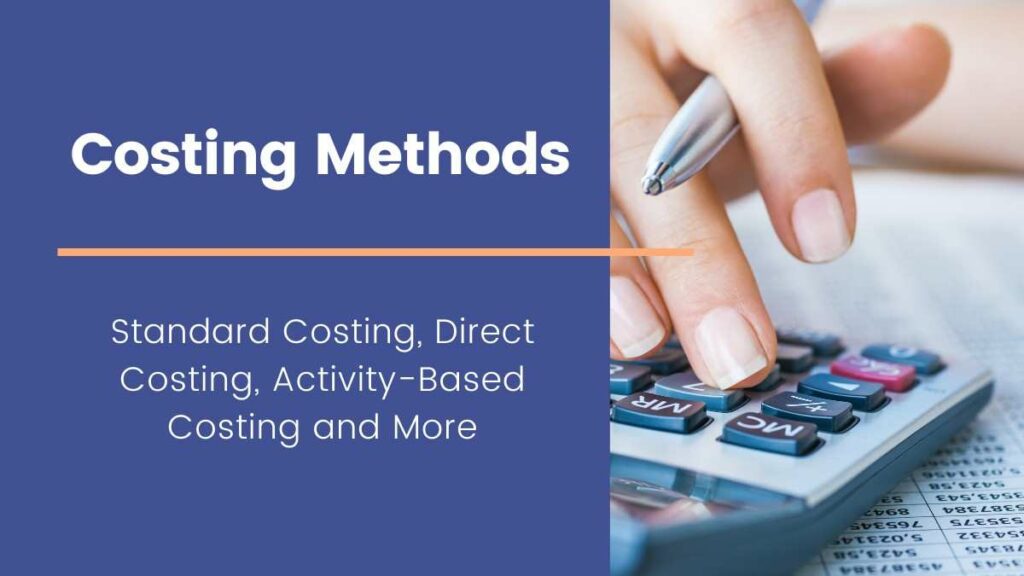Last updated on September 24th, 2024 at 04:46 am
Costing methods are crucial for businesses to understand and control expenses. These methods of cost accounting help organisations allocate costs accurately, enabling them to make informed financial decisions. This blog will delve into various methods of costing, including standard costing, direct costing, and activity-based costing, providing a comprehensive understanding of ‘what is cost accounting?’.
What is Cost Accounting?
Before diving into specific costing methods, it is essential to understand ‘what is cost accounting’. Costing is the process of determining the costs associated with a product, service, or operation. Understanding what is cost accounting helps businesses manage expenses and set competitive prices. Costing methods may vary, but they all aim to provide accurate cost information for better financial management.
Below, we have discussed each type of costing to offer an idea of what each deals with.
Standard Costing
Standard costing is one of the most widely used methods of cost accounting. It involves assigning expected costs to products or services, which are then compared to actual costs incurred. The differences, known as variances, are analysed to improve efficiency and cost control. Standard costing helps businesses maintain budgetary control.
To gain an exhaustive understanding of standard costing along with in-depth knowledge of cost management join a CFO course. The ISB course for chief financial officers offered in collaboration with Imarticus is an excellent programme encompassing various aspects of financial management.
Direct Costing
Direct costing, also known as variable costing, focuses on assigning costs that can be directly traced to a product or service. These include raw materials, labour, and direct expenses. Unlike other methods of costing, direct costing excludes fixed overhead costs, making it simpler and more straightforward. Understanding direct costing is vital for businesses looking to streamline their costing methods and improve profitability.
Activity-Based Costing (ABC)
Activity-based costing (ABC) is a more advanced method of cost accounting that allocates costs based on activities required to produce a product or service. ABC identifies specific activities in the production process and assigns costs to each activity based on resource usage. This method provides a more accurate picture of ‘what is cost accounting’ for each activity, helping businesses identify inefficiencies and optimise processes. Activity-based costing is especially useful for complex operations and is a key topic in many CFO courses.
Other Methods of Costing
In addition to standard costing, direct costing, and activity-based costing, there are several other costing methods businesses can use:
- Job Costing: Job costing assigns costs to specific jobs or batches, making it ideal for custom orders or unique projects. Each job is treated as a separate cost unit, allowing for precise tracking of expenses associated with that particular job. This method is highly effective in industries where products are made to order, such as construction, printing, or specialised manufacturing. By using job costing, businesses can ensure accurate pricing and profitability analysis for each project.
- Process Costing: Process costing is used for the mass production of homogeneous products. This method averages costs over a large number of identical units, simplifying cost allocation. Costs are accumulated for each process or department over a specific period and then divided by the number of units produced. Process costing is commonly applied in industries such as chemicals, textiles, and food processing, where continuous production processes are used.
- Marginal Costing: Marginal costing, also known as variable costing, focuses on the cost of producing one additional unit. This method separates costs into fixed and variable categories, considering only variable costs when calculating the cost per unit. Marginal costing helps businesses make pricing decisions, assess profitability, and determine the impact of production changes on overall costs. It is particularly useful for short-term decision-making and managing variable costs.
- Absorption Costing: Absorption costing allocates all manufacturing costs, both fixed and variable, to products, providing a comprehensive view of production expenses. This method ensures that all costs are included in the valuation of inventory and cost of goods sold. Absorption costing is required for external financial reporting and helps businesses understand the full cost of production, leading to more accurate pricing and profitability analysis.
Importance of Understanding the Various Methods of Costing
Knowing ‘what is cost accounting’ and the various costing methods is crucial for any business. It allows for better financial planning, cost control, and pricing strategies. Whether you're taking a CFO course, an ISB course, or simply seeking to improve your financial management skills, understanding these methods of cost accounting is essential.
It is especially significant for CFOs to master costing methods due to their pronounced impact on strategic decision-making and overall business functionality. Here are the key reasons highlighting its necessity:
1. Accurate Cost Control and Management
Cost accounting helps CFOs monitor and control costs by providing detailed insights into direct and indirect expenses associated with production. By understanding these costs, CFOs can identify areas for cost reduction and efficiency improvements, leading to better financial health for the company.
2. Informed Decision Making
Cost accounting provides essential data for making informed decisions about pricing, budgeting, and financial planning. CFOs can use cost data to evaluate the profitability of different products or services and determine the optimal pricing strategies to maximise profits.
3. Enhanced Profitability Analysis
By determining the total per-unit cost of products or services, cost accounting helps CFOs assess the profitability of each product line. This analysis is critical for strategic decisions such as product discontinuation, resource allocation, and investment in new product development.
4. Efficient Budgeting and Forecasting
Cost accounting aids in accurate budgeting and forecasting by providing a clear picture of fixed and variable costs. CFOs can use this information to prepare realistic budgets, forecast future financial performance, and set achievable financial goals for the organisation.
5. Compliance and Reporting
CFOs are responsible for ensuring that financial reports comply with accounting standards and regulations. Cost accounting helps in the preparation of financial statements that accurately reflect the company’s financial position, ensuring transparency and compliance with regulatory requirements.
6. Resource Allocation
Effective resource allocation is another critical area where cost accounting plays a pivotal role. By analysing cost data, CFOs can determine where to allocate resources to achieve the best return on investment. This involves decisions related to production processes, staffing, and capital expenditures.
7. Competitive Advantage
A thorough understanding of cost accounting allows CFOs to benchmark the company's performance against industry standards and competitors. This benchmarking helps identify areas where the company can improve its cost structure and gain a competitive advantage in the market.
Conclusion
Costing methods play a vital role in business financial management. From standard costing to activity-based costing, each method offers unique advantages and insights into ‘what is cost accounting?’. By mastering these methods, businesses and CFOs can enhance efficiency, control expenses, and improve profitability.
For those looking to delve deeper, pursuing a CFO course or ISB course can provide valuable knowledge and skills in cost accounting. Imarticus’s Chief Financial Officer Programme, offered in partnership with the Indian School of Business, is a great way for ambitious finance professionals to redefine their careers and reach the zenith of financial management. The course will equip them to master skills to shape a high-performing finance team and strategise the growth of their companies effectively.
For detailed information, visit Imarticus today!
Frequently Asked Questions
- Name the 4 main types of cost.
Cost can be broadly classified into 4 prominent categories namely, direct cost, indirect cost, fixed cost and variable cost.
- How can you calculate the total cost?
The formula for calculating total cost (TC) is as follows:
Total Cost (TC) = Total Fixed Cost (TFC)+Total Variable Cost (TVC)
- Give some examples of direct cost.
Salary, expenses incurred due to raw materials, transportation of raw materials and finished products, fuel, utilities, and equipment are some examples of direct costs.
- Define cost sheet.
A cost sheet is a detailed financial document that outlines the various costs incurred by a business in the production of goods or services over a specific period.












